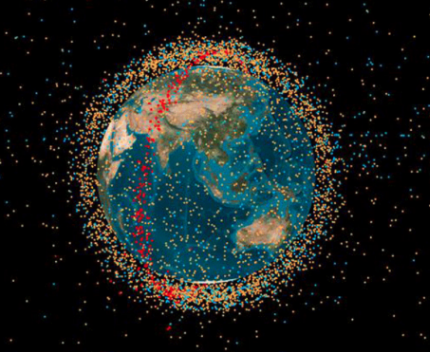Fears rising over traffic jam in space
The commercial satellite industry is increasingly worried about space junk and lack of accurate warnings from DOD satellite trackers.

It's crowded up there: A new study highlights the growing need for space situational awareness.
The growing number of satellites, spent boosters and space junk in low-Earth orbit has prompted a number of efforts to keep closer track of all these objects in order to avoid collisions that would generate dangerous orbital debris fields.
For the U.S. military, the problem is also growing with the proliferation of "cubesats" that often lack a de-orbiting capability, a feature that is mandatory for most satellites. A new study by an industry group addresses the growing need for "space situational awareness" (SSA), calling it "an essential component of conducting the safe and effective operations necessary for mission assurance.
Along with the growing risk of space collisions, the study released by the Satellite Industry Association also warns of the growing risk posed by electronic interference and the effects of space weather.
The industry group applauded the expansion of the Air Force Joint Space Operations Center (JSpOC) to include a "commercial integration cell" designed to coordinate military and commercial space operations. But it nevertheless noted that "actionable SSA" still requires military and commercial operators along with civilian agencies like NASA and the National Oceanic and Atmospheric Administration "to securely share, integrate, and analyze SSA data, including planned maneuvers."
Commercial operators remained concerned, however, over technical and budgetary challenges faced by the U.S. Space Surveillance Network. The network is designed to provide a 24/7 space-tracking capability to meet U.S. national security requirements.
Theresa Hitchens, a senior research scholar at the Center for International Security Studies at the University of Maryland, notes in a just-released study that "most radar facilities used to track space objects are located in the Northern Hemisphere, making continuous coverage of an orbital object impossible."
Moreover, Hitchens cited examples from commercial satellite operators asserting that most collision warnings issued by JSpOC were, according to one Intelsat official, "wrong." Hitchens wrote that the prevailing industry view is that JSpOC advisories are often "inaccurate and not reliable for decision-making about collision avoidance."
Hitchens nevertheless praised the industry group for highlighting the growing need to track satellites and space junk. "It is really good that industry is taking the problems of SSA and debris seriously and is willing to work with regulators and policy makers to solve the problems," she noted in an email.
NEXT STORY: DISA's new cyber HQ starting to branch out



